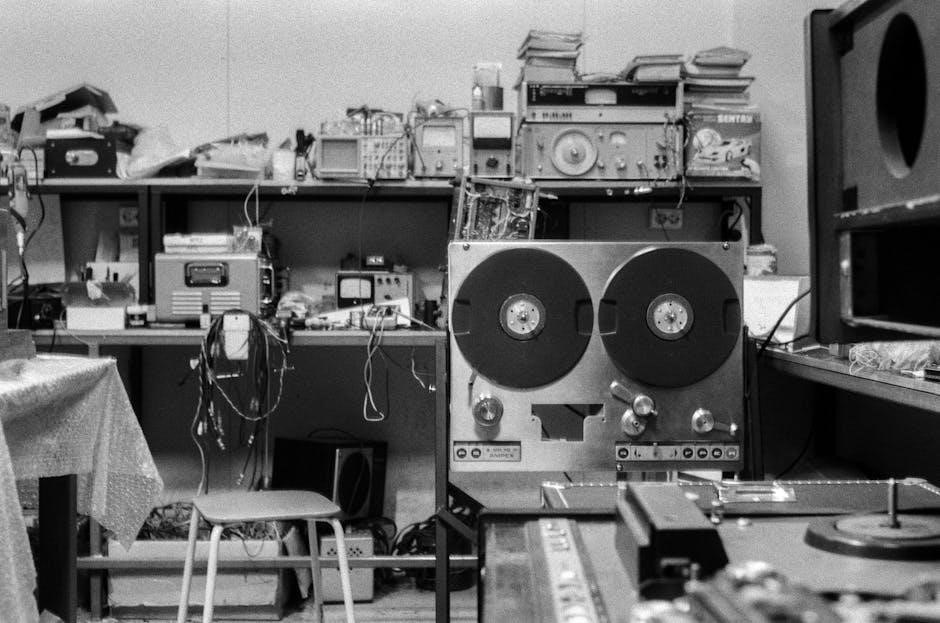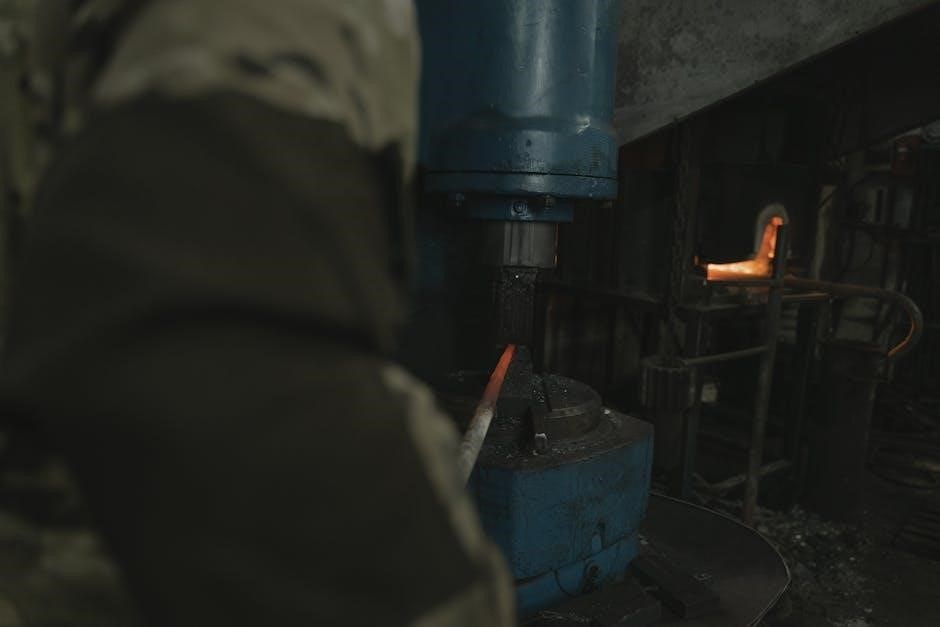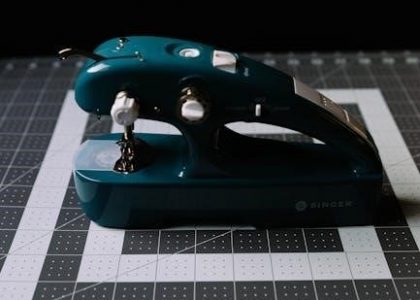The Deep Space Nine Technical Manual is a comprehensive guide detailing the station’s design, technology, and operations. Authored by Rick Sternbach, Herman Zimmerman, and Doug Drexler, it provides in-depth technical specifications, schematic diagrams, and insights into the ships, weapons, and equipment of various species, including Starfleet, Bajoran, and Cardassian technologies.
1.1 Overview of the Manual’s Purpose and Scope
The Deep Space Nine Technical Manual serves as a detailed guide to the station’s design, technology, and operations. It provides comprehensive insights into the ships, weapons, and equipment of various species, including Starfleet, Bajoran, and Cardassian technologies. The manual is designed for fans and creators, offering technical specifications, schematic diagrams, and behind-the-scenes information. It covers the station’s infrastructure, such as power systems and life support, as well as ships like the USS Defiant. This resource is essential for understanding the intricate details of Deep Space Nine and its universe.
1.2 Key Contributors and Their Roles
The Deep Space Nine Technical Manual was authored by a team of Star Trek veterans, including Herman Zimmerman, Rick Sternbach, and Doug Drexler. Herman Zimmerman, the production designer for Deep Space Nine, provided detailed insights into the station’s architecture. Rick Sternbach, a senior illustrator and technical consultant, contributed extensive schematic diagrams and technical data. Doug Drexler, a renowned designer and illustrator, added concept art and additional technical details. Their collective expertise ensures the manual is both accurate and visually rich, offering fans a deep dive into the station’s design and technology.
1;3 Historical Context of Deep Space Nine
Deep Space Nine originated as a Cardassian ore-processing facility known as Terok Nor, constructed during their occupation of Bajor. After the Bajoran liberation, the station was reclaimed and repurposed as a joint Federation-Bajoran outpost. Its strategic location near the Bajoran wormhole made it a critical hub for interstellar trade, diplomacy, and defense. The manual explores this rich history, detailing how the station’s design and technology reflect its complex past under Cardassian rule and its subsequent transformation into a symbol of hope and cooperation for the region.

Design and Layout of Deep Space Nine
The station’s modular design features habitat rings, docking modules, and Ops at its core. It supports diverse activities, from residential quarters to strategic defense operations.
2.1 Habitat Rings and Living Quarters
The habitat rings of Deep Space Nine are designed to provide residential and functional spaces for its diverse population. These modules include crew quarters, civilian accommodations, and communal areas, ensuring comfort and efficiency. The living quarters are tailored to meet the needs of various ranks and roles, from officers to civilians. The design integrates seamlessly with the station’s overall structure, balancing practicality with the unique demands of life aboard a space station.
2.2 Docking Modules and Airlocks
The docking modules of Deep Space Nine are essential for accommodating various spacecraft, including Starfleet vessels, Bajoran interceptors, and visiting alien ships. These modules are equipped with airlocks that ensure safe docking and undocking procedures. The airlocks are designed to maintain internal pressure and provide secure access for crew and passengers. Detailed schematics in the manual highlight the modular design, allowing for flexibility in servicing different ship types while maintaining station security and operational efficiency.
2.3 Operations Center (Ops)
The Operations Center (Ops) is the nerve center of Deep Space Nine, overseeing all station activities. Designed for efficiency, Ops houses critical systems, including tactical, engineering, and communications consoles. The command chair at its center enables the station commander to coordinate operations seamlessly. Detailed schematics in the manual reveal the layout and functionality of each console, highlighting how Ops integrates with other station systems to ensure smooth operation and rapid response to emergencies.

Starfleet Technology and Equipment
The manual details Starfleet’s advanced systems, including phaser technology, shields, and transporters, with detailed schematics and explanations of their operation and integration into the station.
3.1 Phaser Systems and Firepower
The manual provides detailed insights into Starfleet’s phaser systems, including their design, functionality, and tactical applications. It covers the station’s phaser arrays, highlighting their precision and firepower, as well as handheld phasers used by crew members. The text explains the technology behind phaser energy modulation, targeting systems, and safety protocols. Additionally, it explores the integration of phaser systems with the station’s defensive grid, ensuring optimal performance in combat scenarios. This section is essential for understanding the station’s offensive capabilities and Starfleet’s commitment to advanced weaponry.
3.2 Shields and Defensive Mechanisms
The manual details the advanced shielding systems of Deep Space Nine, designed to withstand prolonged attacks. These deflector shields absorb and dissipate energy, protecting the station from enemy firepower. The text explains the multi-layered shielding system, its power allocation, and automatic modulation during combat. Additionally, it covers secondary defensive mechanisms, such as reinforced hull plating and point-defense laser systems. These systems work in tandem to ensure the station’s resilience against various threats, making it a formidable outpost in hostile regions of space.
3.4 Transporters and Beam Technology
The manual provides detailed insights into the transporter systems aboard Deep Space Nine, explaining their operational principles and technical specifications. It covers the dematerialization and rematerialization processes, as well as the integration of Bajoran and Federation technologies. The text includes schematics of the transporter platforms, matter stream alignment, and energy requirements. Additionally, it explores the limitations and safety protocols of beam technology, ensuring crew safety during transport. These details highlight the complexity and precision of transporter systems in the Star Trek universe.

Bajoran and Cardassian Technology
The manual explores Bajoran and Cardassian technologies, detailing their unique designs and functionalities. It highlights Bajoran tricorders, communication devices, and Cardassian ship architecture, showcasing their engineering philosophies.
4.1 Bajoran Tricorder Design
The Bajoran Tricorder Design is meticulously detailed in the manual, showcasing its unique functionality and aesthetic. Unlike Starfleet tricorders, Bajoran designs emphasize simplicity and practicality, reflecting their cultural values. The manual includes cross-sectional views, highlighting internal components and energy sources. It also explains the tricorder’s role in Bajoran medicine and science, providing insights into its advanced sensor capabilities. This section is a must-read for fans interested in the technological nuances of Bajoran innovation and its integration into the Deep Space Nine universe.
4.2 Cardassian Ship Architecture
Cardassian ship architecture, as detailed in the manual, emphasizes angular, utilitarian designs reflecting their military and strategic priorities. The Galor-class cruisers and Keldon-class ships exemplify this style, with overlapping hull plates and internal systems optimized for efficiency. These vessels blend functionality with an intimidating presence, showcasing Cardassian engineering prowess. The manual provides schematics and insights into their propulsion systems, weapon placements, and strategic capabilities, offering a detailed look at the technological and tactical aspects of Cardassian naval design in the Deep Space Nine era.
4.3 Bajoran Communication Devices
The manual details Bajoran communication devices, emphasizing their sleek, functional design. These tools, often integrated into tricorders and personal units, utilize advanced subspace transmission technology. The devices are lightweight, durable, and energy-efficient, reflecting Bajoran resourcefulness. Schematics reveal their internal components, such as crystal oscillators and encryption modules, ensuring secure and reliable communication. These devices play a crucial role in Bajor’s rebuilding efforts and diplomatic interactions, as highlighted in the manual’s detailed technical illustrations and descriptions.

Ships and Vehicles
The manual provides detailed analysis of various ships and vehicles, including the USS Defiant, Danube-Class Runabouts, and Klingon and Romulan vessels, highlighting their unique designs and capabilities.
5.1 USS Defiant: Design and Capabilities
The USS Defiant is a key component of Deep Space Nine’s defense, designed for high-combat situations. Its sleek, compact design maximizes maneuverability and firepower. Equipped with advanced propulsion systems, the Defiant excels in tactical engagements. Its armament includes phaser cannons and quantum torpedo launchers, making it a formidable opponent. The manual details its crew accommodations, bridge layout, and strategic role in the Dominion War, showcasing its significance as a versatile and powerful Starfleet vessel.
5.2 Danube-Class Runabouts
The Danube-Class Runabouts are versatile, multi-mission vessels stationed at Deep Space Nine. Designed for transport, reconnaissance, and combat, they are equipped with advanced propulsion systems and defensive armaments. Their modular design allows for customization, adapting to various mission requirements. The manual provides detailed schematics and operational insights, highlighting their role as essential support craft for the station’s crew. These runabouts are integral to DS9’s operations, offering flexibility and reliability in diverse scenarios.
5.3 Klingon and Romulan Vessels
The Deep Space Nine Technical Manual includes detailed analyses of Klingon and Romulan vessels, showcasing their unique designs and technologies. Klingon ships, such as the Bird of Prey, emphasize firepower and maneuverability, while Romulan Warbirds are renowned for their cloaking devices and plasma weapons. The manual provides schematics and technical data, offering insights into the strategic advantages of these vessels. These designs reflect the military and tactical priorities of their respective cultures, making them formidable opponents in the galaxy. The manual’s coverage of these ships enhances understanding of their roles in the Star Trek universe.

Weapons and Defensive Systems
This section details the advanced weaponry and defensive systems of Deep Space Nine, including phaser arrays, torpedo launchers, and shield mechanisms, ensuring optimal station protection and combat readiness.
6.1 Phasers and Disruptors
The Deep Space Nine Technical Manual details the advanced phaser systems and disruptor technologies used by various species. Phasers, primarily employed by Starfleet, feature adjustable settings for stun or disintegration, while disruptors, favored by species like the Cardassians, deliver high-energy bursts with devastating effects. Both systems are powered by energy cells and are integral to the station’s defense and tactical operations. The manual provides detailed schematics and technical specifications, offering insights into their design, functionality, and strategic applications in combat scenarios.
6.2 Torpedo Launchers and Payloads
The Deep Space Nine Technical Manual outlines the advanced torpedo systems utilized by the station and its affiliated vessels. These include photon and quantum torpedoes, designed for maximum impact in combat scenarios. The manual details the launchers’ mechanisms, payload capacities, and targeting systems, ensuring precision and efficiency. Torpedo technology plays a critical role in the station’s defensive and offensive strategies, making it a cornerstone of Deep Space Nine’s tactical arsenal. The specifications provided offer a glimpse into the engineering prowess behind these lethal weapons.
6.3 Station-Based Defense Systems
The Deep Space Nine Technical Manual details the station’s robust defense mechanisms, including shields and phaser emplacements. These systems are strategically integrated into the station’s design to provide maximum protection against hostile attacks. The manual explains the operational parameters of these defenses, such as power requirements and targeting systems. Additionally, it highlights the station’s ability to adapt its defensive posture based on evolving threats, ensuring Deep Space Nine remains a formidable presence in the region. These systems are crucial for safeguarding the station and its occupants.

Operational Systems and Infrastructure
The manual details Deep Space Nine’s power generation, life support, and environmental systems, ensuring sustained operations. These systems are vital for maintaining the station’s functionality and habitability.
7.1 Power Generation and Distribution
The Deep Space Nine Technical Manual reveals the station’s power systems, relying on fusion reactors and energy storage units. Power distribution is managed through a centralized grid, ensuring efficient energy allocation across all systems. The manual details how energy is routed to critical areas like life support, propulsion, and defensive systems. Backup power sources, such as auxiliary generators, are also outlined, providing redundancy during emergencies. This section offers a detailed look at the engineering behind the station’s energy needs and distribution processes.
7.2 Life Support and Environmental Systems
The Deep Space Nine Technical Manual elaborates on the station’s life support systems, designed to sustain thousands of inhabitants. Air recycling, temperature control, and humidity management are meticulously detailed. The manual explains how oxygen is replenished and carbon dioxide removed, ensuring a breathable environment. Water purification and waste recycling systems are also covered, emphasizing sustainability. These systems are integrated to maintain a stable ecosystem, crucial for the station’s diverse population, including crew, civilians, and visitors from various species.
7.3 Wastewater Treatment and Recycling
The Deep Space Nine Technical Manual provides detailed insights into the station’s wastewater treatment and recycling systems. These systems are crucial for sustaining life onboard, ensuring water conservation through advanced filtration and purification processes. The manual explains how wastewater is collected, treated, and recycled for reuse, minimizing the station’s environmental impact. This sustainable approach supports the station’s self-sufficiency, especially during prolonged missions or when resupply is unavailable. The systems are designed to handle diverse waste streams, maintaining a healthy and efficient environment for all inhabitants.

The USS Defiant: Detailed Analysis
The USS Defiant is a prototype starship designed for combat, featuring advanced weaponry and a compact, maneuverable design. The manual provides detailed schematics and technical insights.
8.1 Propulsion Systems
The USS Defiant’s propulsion systems are designed for high-speed combat efficiency. Its warp drive enables rapid response, while advanced impulse engines provide sublight maneuverability. The ship’s thrusters are optimized for precise control in battle scenarios. The manual details the Defiant’s compact design, allowing for higher power allocation to propulsion. This setup enhances its tactical capabilities, making it a formidable vessel in deep space engagements. The propulsion systems are integral to the Defiant’s role as a versatile and powerful starship.
8.2 Tactical Systems and Armament
The USS Defiant is equipped with advanced tactical systems, including phaser cannons and quantum torpedo launchers. Its armament is optimized for combat, with a focus on precision and firepower. The manual details the ship’s offensive capabilities, such as rapid-fire phasers and high-yield torpedo payloads. Strategic systems like targeting sensors and power allocation ensure maximum efficiency in battle. The Defiant’s design emphasizes offensive tactics, making it a formidable opponent in deep space engagements. Its armament reflects its role as a high-performance combat vessel.
8.3 Crew Accommodations and Bridge Layout
The USS Defiant’s crew accommodations are minimal yet functional, reflecting its role as a high-performance combat vessel. Living quarters are compact, designed for efficiency rather than comfort, ensuring crew readiness for extended missions. The bridge layout prioritizes tactical efficiency, with streamlined controls and advanced consoles. The captain’s chair is centrally located, offering clear access to command systems. Tactical and operations stations are positioned for rapid decision-making, emphasizing the ship’s focus on strategic operations and combat readiness.

Alien Technologies and Adaptations
The manual explores advanced technologies from various species, including Dominion, Ferengi, and Klingon innovations, detailing their unique energy weapons, communication systems, and strategic adaptations for interstellar dominance.
9.1 Dominion Technology Overview
The Dominion’s technology is centered around biotechnology and resource efficiency, with ships like the Jem’Hadar vessels showcasing sleek, functional designs. Their advanced propulsion systems enable rapid deployment across vast distances. Energy weapons and shields are integral to their arsenal, reflecting their militaristic culture. The manual details how Dominion tech integrates seamlessly with their biology, emphasizing adaptability and resilience. This overview highlights their strategic use of technology to maintain control and project power, making them a formidable force in the galaxy.
9.2 Jem’Hadar Ships and Equipment
The Jem’Hadar ships are bioengineered vessels, designed for efficiency and combat. Their sleek, organic designs reflect the Dominion’s emphasis on functionality. Equipped with advanced propulsion systems, these ships excel in speed and maneuverability. Energy weapons and shields are standard, making them formidable opponents. The manual provides detailed schematics of Jem’Hadar fighters and cruisers, highlighting their unique blend of technology and biology. This section offers insights into the strategic use of these ships, showcasing their role in Dominion military tactics and their adaptability in various combat scenarios.
9.3 Ferengi Trade and Technology
The Ferengi Alliance, driven by profit, employs unique technologies tailored to commerce and trade. Their ships, like the Ferengi Marauder, are designed for speed and cargo efficiency. The manual details their advanced replicator systems, used for both production and resource management. Ferengi technology often integrates cunning business strategies, reflecting their mercantile culture. This section explores their resourcefulness in adapting technology for financial gain, showcasing their distinct approach to innovation and trade in the galaxy.
Behind the Scenes: Creating the Manual

The Deep Space Nine Technical Manual was crafted by Rick Sternbach, Herman Zimmerman, and Doug Drexler, blending detailed schematics with rich illustrations to provide an authentic in-universe perspective.
10.1 Concept Art and Design Process
The creation of the Deep Space Nine Technical Manual involved a meticulous design process, blending concept art with technical precision. Rick Sternbach and Herman Zimmerman collaborated to ensure accuracy, drawing from their work on the series. The manual features detailed schematics, cross-sections, and isometric illustrations, providing a visual blueprint of the station and its associated vessels. This process highlighted the balance between artistic vision and technical authenticity, offering fans a unique glimpse into the design philosophy behind Deep Space Nine and its universe.
10.2 Schematic Diagrams and Illustrations
The Deep Space Nine Technical Manual is renowned for its extensive collection of schematic diagrams and detailed illustrations. These visuals provide intricate cross-sections of the station, its modules, and associated vessels like the USS Defiant. The manual also includes annotated exterior views and isometric drawings of key locations, offering a visual blueprint for fans and creators. These illustrations, crafted by the show’s designers, bring the technical aspects of Deep Space Nine to life, making the manual an invaluable resource for understanding its complex architecture and technology.
10.3 Challenges in Technical Accuracy
Creating the Deep Space Nine Technical Manual posed significant challenges in maintaining technical accuracy. The authors had to balance creative vision with realistic engineering principles. Ensuring consistency across the station’s design, from habitat rings to docking modules, required meticulous attention to detail. Additionally, accurately representing diverse alien technologies, such as Bajoran and Cardassian systems, added complexity. The team also faced the task of translating conceptual art into precise schematics, making the manual both visually engaging and technically credible for fans and creators alike;
The Deep Space Nine Technical Manual remains a cornerstone for fans and creators, offering unparalleled insights into the station’s design and technology, ensuring its enduring relevance.
11.1 Impact on Star Trek Fandom
The Deep Space Nine Technical Manual has become a cornerstone for fans, offering detailed insights into the station’s design and technology. Its rich content, including schematic diagrams and ship designs, has captivated both casual and hardcore fans. By providing a deeper understanding of the Star Trek universe, it has inspired countless discussions, fan art, and creative projects. The manual’s meticulous attention to detail has solidified its place as a must-have resource, ensuring its enduring relevance within the Star Trek community.
11.2 Relevance for Modern Fans and Creators
The Deep Space Nine Technical Manual remains a vital resource for modern fans and creators, offering detailed schematics and technical insights. Its cross-sections of ships, weapons, and equipment inspire fan art and fiction. For creators, the manual provides a blueprint for understanding Star Trek’s universe, aiding in world-building and design. Its visuals and explanations continue to captivate, ensuring its relevance in today’s fandom. The manual’s enduring appeal lies in its ability to bridge technical depth with creative inspiration, making it a timeless asset for both enthusiasts and professionals.





